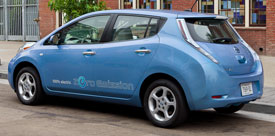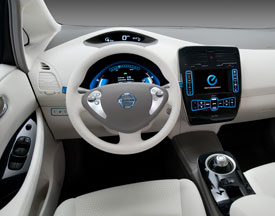2010 is clearly the year of the electric car. So far this season we’ve driven the Mitsubishi i-MiEV, MINI E, Tesla Roadster, the Chevrolet Volt, and even this Toyota Prius plug-in hybrid. But this week we turn our road test eyes to the first modern, pure-electric, five-passenger family car to enter mass production, the Nissan LEAF. Now, the compact LEAF could forever change the way we think about everyday cars. So, come along, and you be the judge, as we turn over the new leaf!
Loosely based on the Nissan Versa, the zero-tailpipe emissions 2011 Nissan LEAF is powered by an air-cooled, 24-kilowatt-hour lithium-ion battery pack mounted under the floor pan and rear seats of the car. Its 192 cells are tied to an 80-kilowatt synchronous AC electric motor. With 107 horsepower and 206 pound-feet of torque, it pulls the LEAF to a top speed of 90 miles per hour.
Fully charged, the LEAF has a range of 60 to 120 miles, depending on weather conditions. That’s enough to cover most roundtrip commutes without too much range anxiety. But, since it has no backup power source like the Chevrolet Volt, for long distances, the LEAF is a non-starter.
A full recharge using 110 household current takes an impractical 20 hours. Installing an optional 220-volt home charging station drops it to about 8 hours. Nissan also plans to install commercial quick-charge stations in parking lots that will provide 80 percent recharge in just 30 minutes.
 On the road, the LEAF drives with the spirit of a peppy, front drive compact car, albeit an extremely quiet one. As with most electric motored cars, the LEAF delivers peak torque right off the line. A non-instrumented 0 to 60 run of 8 seconds confirmed LEAF to be fairly brisk. And, with no transmission, everything is smooth and machine like.
On the road, the LEAF drives with the spirit of a peppy, front drive compact car, albeit an extremely quiet one. As with most electric motored cars, the LEAF delivers peak torque right off the line. A non-instrumented 0 to 60 run of 8 seconds confirmed LEAF to be fairly brisk. And, with no transmission, everything is smooth and machine like.
The LEAF’s suspension is basic economy car; MacPherson struts up front and a torsion beam in the rear. Stability and traction control are standard.
And, when the road turns, the LEAF holds its own very well. With the 600-pound battery pack down low, the LEAF feels planted and stable. The car is quite nimble, and sportier than expected, with the electric power steering being reasonably precise.
There is regenerative braking, of course, and it is relatively mild in Normal Mode. Switch to Economy mode and the throttle grows softer and the regenerative braking grows harsher. Otherwise, the all-disc ABS system with Brake Assist reacts well to panic stops.
Ride is comfortable too, absorbing broken city pavement without great drama. All in all, the LEAF drives normally, like a traditional, well-built compact family car. And it looks pretty normal, too. The LEAF has unique styling without going for an eco-freakmobile look. It’s more consistent with current Nissan products like Rogue, Juke, and Versa.
The bug-eyed, bulbous compact five-door hatchback is longer than the Versa hatchback, and a little shorter than the Chevrolet Volt. It’s all very aerodynamic, with the large LED headlamps carefully shaped to keep wind noise low. On profile the LEAF is seamless and sprawling, with an almost mid-size stance. The standard 16-inch alloy wheels help that impression as well. The back-end is also quite normal, with a large hatch flanked by tall, thin taillights, and topped by a roof spoiler.
 For a more futuristic look, you have to dive inside the LEAF. It’s clean, inviting, and loaded with soft touch controls and animated displays. There’s lots of plastic, but it has a good quality look and feel to it. Seats are all-day comfortable, with coverings made from recycled materials.
For a more futuristic look, you have to dive inside the LEAF. It’s clean, inviting, and loaded with soft touch controls and animated displays. There’s lots of plastic, but it has a good quality look and feel to it. Seats are all-day comfortable, with coverings made from recycled materials.
The center dash houses the standard navigation system, and a mouse like shifter that took about a nanosecond to get use to.
Other techie standard equipment on the base LEAF SV includes push button start, cruise, Bluetooth, automatic temperature control, and CARWINGS, a Smartphone feature that allows for remote monitoring of the charging status. The uplevel SL adds backup camera, HomeLink, and a solar panel to keep a small battery charged for the audio system.
The rear seat offers normally-tight compact car leg room, and while there are three seatbelts, only two adults will fit comfortably. There is, however, some compromise in the cargo bay. Part of the onboard charging mechanism creates a hump at the forward end. But when the rear seats are folded, they line up perfectly and eliminate this objection.
Obviously, the traditional miles per gallon measure doesn’t apply to the LEAF. But the cost to fully recharge it is about $3. That’s nearly twice that of the Chevrolet Volt, but then, the LEAF offers about twice the all-electric driving range, too. Nissan expects an official government miles per gallon energy equivalent rating in the triple digits.
There are some notable digits in LEAF’s price as well. Base sticker is $33,600, before federal and state tax credits. Most buyers will be able to drop that price to $26,100. However, we think leasing the LEAF is the way to go, at $1999 down and $349 per month. That’s on par with a lease for the Chevy Volt. The 220-volt charging station will cost you about $2,200 installed, but that too is eligible for tax credits.
Beyond being a pure-electric vehicle, the 2011 Nissan LEAF is a well-equipped and capable compact car. It’s hard to see how it can be your only car, unless your radius of travel is very limited. But, then, there are always rentals. So, we find that LEAF does indeed keep its promises, and along with Volt, is a promising start to a new electric family car age. And, we can’t wait to see what comes next.
Specifications
- Engine: 80-kilowatt Synchronous Ac Electric Motor
- Horsepower: 107
- Torque: 206 Lb Feet
- 0-60 MPH: 8.0 Seconds
Long Term Updates
When we took delivery of our long term Nissan Leaf electric car, we weren’t sure how we would use it. After all, the anxiety of running out of power seemed very real.
But, we adapted. We found the Nissan Leaf makes a great second car; perfect for reasonable commutes, around town errands, and just about anything short of long distance vacations.
But, while we often saw driving range indicated at over 100 miles, using heat or a/c, 65-70 was more reality.
With mostly short haul use, we had no trouble keeping it fully charged using household 110 Volts. Still, if we owned one, installing a 220 Volt charger would be best.
After 9 months, we can say the light, eco-friendly upholstery has taken quite a beating. It’s not very stain resistant. But, driving enjoyment has only grown. The Leaf is quiet, quick, and agile.
So as we bid goodbye to our Leaf, we conclude that EVs are indeed viable, and we sure will miss this one.
Mileage: 1,300After two months and with 1,300 commuter miles on the digital odometer, our staff is very pleased with the practicality of this pioneering EV. The Leaf is comfortable, able to haul plenty of household goods, while still bordering on fun-to-drive. The range indicator always drops faster than expected when you’re first starting out, and so far we’ve used heat and a/c sparingly to extend range. But, we’ve never come close to running out of power. With the hottest months of summer ahead, we’ll see if we can keep our cool in the Nissan Leaf.







 On the road, the LEAF drives with the spirit of a peppy, front drive compact car, albeit an extremely quiet one. As with most electric motored cars, the LEAF delivers peak torque right off the line. A non-instrumented 0 to 60 run of 8 seconds confirmed LEAF to be fairly brisk. And, with no transmission, everything is smooth and machine like.
On the road, the LEAF drives with the spirit of a peppy, front drive compact car, albeit an extremely quiet one. As with most electric motored cars, the LEAF delivers peak torque right off the line. A non-instrumented 0 to 60 run of 8 seconds confirmed LEAF to be fairly brisk. And, with no transmission, everything is smooth and machine like. For a more futuristic look, you have to dive inside the LEAF. It’s clean, inviting, and loaded with soft touch controls and animated displays. There’s lots of plastic, but it has a good quality look and feel to it. Seats are all-day comfortable, with coverings made from recycled materials.
For a more futuristic look, you have to dive inside the LEAF. It’s clean, inviting, and loaded with soft touch controls and animated displays. There’s lots of plastic, but it has a good quality look and feel to it. Seats are all-day comfortable, with coverings made from recycled materials.



































